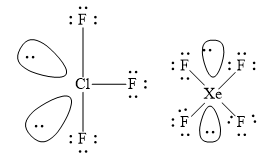
(a) Account for the following:
(i) Acidic character increases from HF to HI.
(ii) There is a large difference between melting and boiling points of oxygen and sulphur.
(iii) Nitrogen does not form pentahalide.
(b) Draw the structures of the following
(i) \[{\text{Cl}}{{\text{F}}_3}\]
(ii) \[{\text{Xe}}{{\text{F}}_4}\]
Answer
510.8k+ views
Hint: (a)
(i) Acid strength increases with decrease in bond dissociation energy.
(ii) Atomic size, electronegativity and atomicity affects melting and boiling points.
(iii) Lack of d orbitals in the valence shell.
(b)\[{\text{Cl}}{{\text{F}}_3}\] and \[{\text{Xe}}{{\text{F}}_4}\] have T shaped and square planar geometry respectively.
Complete answer:
(i) The acidic strength of the hydrohalic acids increase from HF because the stability of the acids decrease from HF to HI on account of decrease in bond dissociation enthalpy of H−X bond from HF to HI.
> With increase in the size of the halogen atom, bond dissociation energy decreases from HF to HI. The ease with which protons can be donated increases from HF to HI. Hence, acidic character increases from HF to HI.
(ii) Oxygen atoms are smaller in size than sulphur atoms. Oxygen is more electronegative than sulphur. Also oxygen is a diatomic ($O_2$) molecule whereas sulphur ($S_8$) has eight atoms in the molecule. Due to these factors, there is a large difference between melting and boiling points of oxygen and sulphur.
In the modern periodic table, nitrogen atoms are present in the second period. Hence, nitrogen does not have ‘d’ orbitals. Due to this, in the valence shell of nitrogen, only one s three and p orbitals can be used. This restricts the maximum covalency of nitrogen to four. So nitrogen cannot form pentahalides.
(b)
The structures are as shown below:

(i) \[{\text{Cl}}{{\text{F}}_3}\] has three bond pairs of electrons and two lone pairs of electrons. The electron pair geometry is trigonal bipyramidal and molecular geometry is T shaped.
(ii) \[{\text{Xe}}{{\text{F}}_4}\] has four bond pairs of electrons and two lone pairs of electrons. The electron pair geometry is octahedral and molecular geometry is square planar.
Note: :The shape of the molecule is determined by the nature of hybridisation. Hybridisation depends on steric numbers. Steric number is the total number of bond pairs and lone pairs of electrons.
(i) Acid strength increases with decrease in bond dissociation energy.
(ii) Atomic size, electronegativity and atomicity affects melting and boiling points.
(iii) Lack of d orbitals in the valence shell.
(b)\[{\text{Cl}}{{\text{F}}_3}\] and \[{\text{Xe}}{{\text{F}}_4}\] have T shaped and square planar geometry respectively.
Complete answer:
(i) The acidic strength of the hydrohalic acids increase from HF because the stability of the acids decrease from HF to HI on account of decrease in bond dissociation enthalpy of H−X bond from HF to HI.
> With increase in the size of the halogen atom, bond dissociation energy decreases from HF to HI. The ease with which protons can be donated increases from HF to HI. Hence, acidic character increases from HF to HI.
(ii) Oxygen atoms are smaller in size than sulphur atoms. Oxygen is more electronegative than sulphur. Also oxygen is a diatomic ($O_2$) molecule whereas sulphur ($S_8$) has eight atoms in the molecule. Due to these factors, there is a large difference between melting and boiling points of oxygen and sulphur.
In the modern periodic table, nitrogen atoms are present in the second period. Hence, nitrogen does not have ‘d’ orbitals. Due to this, in the valence shell of nitrogen, only one s three and p orbitals can be used. This restricts the maximum covalency of nitrogen to four. So nitrogen cannot form pentahalides.
(b)
The structures are as shown below:

(i) \[{\text{Cl}}{{\text{F}}_3}\] has three bond pairs of electrons and two lone pairs of electrons. The electron pair geometry is trigonal bipyramidal and molecular geometry is T shaped.
(ii) \[{\text{Xe}}{{\text{F}}_4}\] has four bond pairs of electrons and two lone pairs of electrons. The electron pair geometry is octahedral and molecular geometry is square planar.
Note: :The shape of the molecule is determined by the nature of hybridisation. Hybridisation depends on steric numbers. Steric number is the total number of bond pairs and lone pairs of electrons.
Recently Updated Pages
Why are manures considered better than fertilizers class 11 biology CBSE

Find the coordinates of the midpoint of the line segment class 11 maths CBSE

Distinguish between static friction limiting friction class 11 physics CBSE

The Chairman of the constituent Assembly was A Jawaharlal class 11 social science CBSE

The first National Commission on Labour NCL submitted class 11 social science CBSE

Number of all subshell of n + l 7 is A 4 B 5 C 6 D class 11 chemistry CBSE

Trending doubts
Differentiate between an exothermic and an endothermic class 11 chemistry CBSE

10 examples of friction in our daily life

One Metric ton is equal to kg A 10000 B 1000 C 100 class 11 physics CBSE

Difference Between Prokaryotic Cells and Eukaryotic Cells

1 Quintal is equal to a 110 kg b 10 kg c 100kg d 1000 class 11 physics CBSE

State the laws of reflection of light




